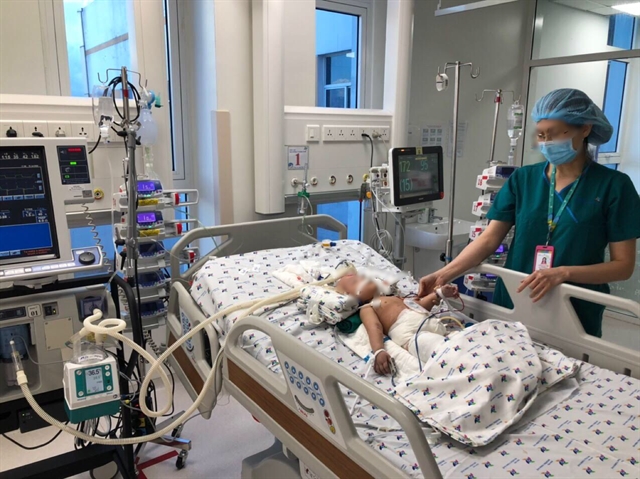 Society
Society


|
| A pair of 13-month-old conjoined twins who were separated on July 15 is recuperating at the City Children’s Hospital in HCM City. Photo courtesy of the hospital’s doctor. |
HCM CITY— The 13-month-old conjoined twins who had surgery to separate them on July 15 at the City Children’s Hospital in HCM City no longer have fever.
They are showing signs of good recovery.
Doctors are closely monitoring their respiration, digestion and other functions. They are getting the best care to ensure they are in optimal health for more surgeries.
They plan to perform a secondary surgery to reconstruct the babies’ digestive and urinary tracts after three months.
Dr Trương Quang Định, the hospital’s director, said the doctors had worked closely with Hùng Vương Hospital, where the twins were born in June 2019, to prepare for the surgery to separate them by 93 doctors and nurses from leading city hospitals such as Children’s Hospitals 1 and 2 and Chợ Rẫy Hospital.
Định said many more things like physical rehabilitation are needed for the babies.
Speaking at a press meeting after the surgery, Prof Trần Đông A, 79, who headed the team of surgeons that did the first ever surgery in Việt Nam to separate conjoined twins in 1988 and was a consultant for the surgery this month, said it was a big challenge for doctors because the babies were joined at the pelvis and all four lower limbs were present and at right angles to the common torso.
The global rate of conjoined twins is 1 per 200,000 live births, and only 6 per cent are classified as ischiopagus tetrapus conjoined twins, or joined at the pelvis.
“Thirty two years ago we successfully performed the surgery to separate the twins who were also joined at the pelvis like the 13 month-old twins, despite a shortage of materials such as antibiotics and sutures.
“We received assistance from Japan.”
The twins, Nguyễn Việt and Nguyễn Đức of Kon Tum had had the surgery when they were six years old. Việt had cerebral palsy, was in a coma and his life was under threat. If he died, Đức could also die, and so the surgery had to be done to separate and save Đức.
Việt might also have a chance to survive then.
The surgery lasted 15 hours.
Đức grew up into a healthy adult and got married while, sadly, Việt remained in a vegetative state for 19 years before passing away.
Doctors of Việt Nam have so far performed 11 surgeries to separate conjoined twins.
Fifty doctors and nurses at Việt Nam National Children’s Hospital, for instance, performed a 10-hour surgery to separate a 10-month-old pair joined at the abdomen, chest, liver, duodenum, and small intestine in 2003.
Experts had warned of risks but the outcome exceeded expectations.
The twins have grown up healthy and are preparing to sit the upcoming high school graduation examination. VNS




